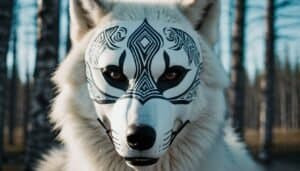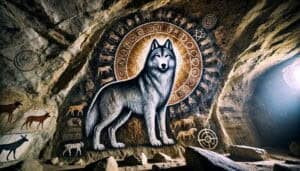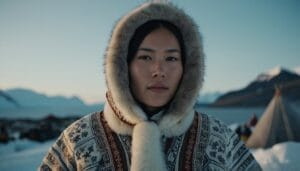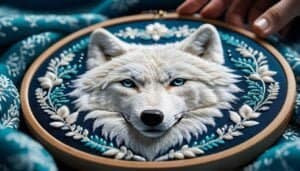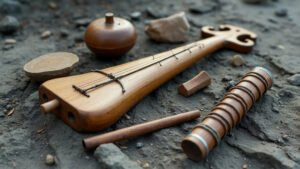Introduction
Arctic wolves have been a profound source of inspiration for Arctic artists, reflected in carvings and sculptures that capture their essence and cultural significance
This article explores the materials and techniques used to create these artworks, the portrayal and symbolism of Arctic wolves, their historical and cultural context, notable artworks and artists, integration into other art forms, and their role in mythology and folklore
By delving into these aspects, we gain a deeper understanding of how Arctic wolves are depicted in Arctic art and their importance to the cultures that create them
Materials and Techniques for Arctic Wolf Art
Arctic wolf art, particularly carvings and sculptures, showcases the rich traditions and skills of Arctic artisans. The materials and techniques employed in these artworks are deeply rooted in the environment and culture of the Arctic region
Understanding these materials and methods provides insight into the craftsmanship and cultural significance of these pieces
Traditional Materials
Traditional materials used in Arctic wolf carvings and sculptures are primarily sourced from the natural environment, reflecting the resourcefulness and deep connection of Arctic peoples to their surroundings
Common traditional materials include:
Ivory: Ivory, particularly from walrus tusks, has been a favored material for Arctic carvings
Inuit artists have used ivory for centuries to create intricate and detailed sculptures of Arctic wolves, among other subjects. The fine grain and durability of ivory allow for precise carving and a smooth finish, making it ideal for depicting the delicate features of wolves
Bone: Bones from various animals, including caribou and whales, are also commonly used
These materials are abundant in the Arctic and have been utilized for both functional and artistic purposes. Bone carvings often exhibit a raw, textured appearance that adds to the realism of the depicted Arctic wolves
Stone: Soapstone and other soft stones are frequently used in Arctic sculptures
Soapstone is particularly popular due to its softness, which makes it easier to carve intricate details. The natural colors and patterns of the stone can enhance the visual appeal of the sculptures
Wood: Driftwood and other types of wood are used for larger carvings
Wood provides a versatile medium that can be shaped and polished to create both detailed and stylized representations of Arctic wolves. The use of wood is often seen in totemic art and larger installations
Modern Materials
While traditional materials remain popular, contemporary Arctic artists have also incorporated modern materials and techniques into their work. This evolution reflects both the availability of new resources and the changing artistic expressions of Arctic cultures
Modern materials include:
Synthetics: Synthetic materials such as resins and plastics are sometimes used in modern sculptures. These materials offer greater flexibility and durability, allowing artists to experiment with new forms and finishes. Synthetic materials can also be colored and textured in ways that are difficult to achieve with natural materials
Metals: Metals like bronze and aluminum have found their way into Arctic art. These materials are used for both small-scale sculptures and larger public installations. Metal sculptures can endure harsh weather conditions, making them suitable for outdoor display in the Arctic environment
Mixed Media: Contemporary artists often use a combination of traditional and modern materials, creating mixed media pieces that blend old and new techniques. This approach allows for innovative expressions and can highlight contrasts between traditional and modern Arctic life
The integration of traditional and modern materials in Arctic wolf carvings and sculptures not only showcases the adaptability and creativity of Arctic artists but also underscores the enduring cultural significance of the Arctic wolf in their art
Whether using ivory, bone, stone, wood, synthetics, metals, or a combination thereof, these artists continue to honor their heritage while embracing new possibilities
Depictions and Symbolism in Arctic Art
The portrayal of Arctic wolves in carvings and sculptures reflects their integral role in the lives and imaginations of Arctic peoples
These depictions are not merely artistic renditions but are imbued with cultural significance and symbolism, conveying various aspects of the wolves’ behaviors and their meanings within Arctic cultures
Portrayal of Behavior
Arctic carvings and sculptures often capture the behaviors of wolves, emphasizing their roles as hunters and social animals
The detailed representations provide insight into how Arctic peoples perceive and relate to these animals:
Hunting Scenes: Arctic wolves are frequently depicted in hunting scenes, showcasing their prowess and strategic abilities
These scenes might show wolves stalking prey, demonstrating their patience and cooperation. For example, an Inuit carving may depict a pack of wolves encircling a caribou, highlighting the wolves’ coordinated efforts and tactical intelligence
Pack Dynamics: The social structure and dynamics of wolf packs are also a common theme in Arctic art
Sculptures often show wolves in various interactions, such as nurturing their young or engaging in playful activities. These depictions emphasize the communal and familial bonds within a wolf pack, reflecting the importance of kinship and cooperation in Arctic cultures
Symbolism and Meanings
Arctic wolf depictions are rich in symbolism, often conveying deeper meanings and values
The wolves are seen not just as animals but as embodiments of traits and lessons that are integral to the cultural fabric of Arctic communities:
Strength and Resilience: Wolves are symbols of strength and resilience, qualities highly valued in the harsh Arctic environment
Carvings and sculptures that portray wolves overcoming challenges or enduring harsh conditions serve as metaphors for the perseverance and endurance of Arctic peoples
Guidance and Protection: In many Arctic cultures, wolves are regarded as guides and protectors
This symbolism is evident in totemic art and shamanistic practices, where wolves are depicted as spiritual guardians. For instance, a sculpture might show a wolf leading a human figure, symbolizing guidance through life’s uncertainties
Balance and Harmony: The wolf’s role in maintaining ecological balance is another symbolic aspect depicted in Arctic art
Wolves are crucial predators in their ecosystems, and their presence ensures the health of prey populations and vegetation. Artworks that highlight this balance reflect a broader cultural understanding of interconnectedness and respect for nature
Mythological Significance: Wolves feature prominently in Arctic mythology and folklore, where they are often portrayed as transformative beings or messengers
These mythical depictions can include wolves with human attributes or engaging in supernatural acts, illustrating their revered status in Arctic lore
The intricate and meaningful portrayals of Arctic wolves in carvings and sculptures are a testament to the deep cultural connections between Arctic peoples and their environment. By examining these artistic representations, we gain a deeper appreciation for the values and beliefs that shape Arctic societies
Historical and Cultural Context
Understanding the historical and cultural context of Arctic wolf depictions in carvings and sculptures provides valuable insights into the rich heritage of Arctic peoples. These artworks are not only aesthetic expressions but also documents of historical significance and cultural identity
Indigenous Cultures
Arctic wolf art is deeply rooted in the traditions of indigenous cultures that have inhabited the Arctic region for millennia
These communities have developed unique artistic practices that reflect their connection to the land and its fauna:
Inuit Traditions: The Inuit are among the most renowned for their intricate carvings and sculptures of Arctic wolves. Using materials like ivory, bone, and stone, Inuit artists have created detailed representations that capture the essence of wolves in their natural environment
These artworks often serve both decorative and ceremonial purposes, illustrating the central role wolves play in Inuit culture. Inuit legends and stories frequently feature wolves, underscoring their significance in the community’s oral traditions
Other Arctic Peoples: Other indigenous groups, such as the Yupik and Chukchi, also produce notable wolf carvings and sculptures. Each group brings its unique style and interpretation, influenced by their specific environmental conditions and cultural narratives
For example, Chukchi wolf sculptures might emphasize the spiritual connection between humans and wolves, reflecting their shamanistic practices
Evolution Over Time
The depiction of Arctic wolves in art has evolved over time, influenced by changing environmental, social, and cultural factors
This evolution highlights the adaptability and resilience of Arctic cultures:
Early Depictions: Early Arctic wolf carvings and sculptures were primarily functional, often serving as tools or talismans
These early artworks were simplistic but held significant cultural and spiritual meaning. As artistic techniques developed, the depictions became more detailed and expressive, reflecting a deeper understanding of wolf anatomy and behavior
Contact with Western Cultures: The arrival of Western explorers and traders in the Arctic brought new materials and artistic influences
Indigenous artists began to incorporate these new elements into their work, resulting in a fusion of traditional and Western styles. This period saw a diversification in the themes and techniques used in Arctic wolf art, with artists experimenting with new forms and perspectives
Contemporary Trends: Today, Arctic wolf art continues to evolve, blending traditional motifs with contemporary styles. Modern Arctic artists draw inspiration from their heritage while addressing current issues such as climate change and cultural preservation
This contemporary art movement seeks to maintain the cultural identity of Arctic peoples while engaging with a global audience. For instance, modern sculptures might use recycled materials to comment on environmental sustainability, reflecting the ongoing relationship between Arctic peoples and their environment
The historical and cultural context of Arctic wolf depictions in art reveals the enduring significance of these animals in Arctic societies. From early functional carvings to contemporary artistic expressions, these artworks provide a window into the values, beliefs, and experiences of Arctic peoples throughout history
Notable Artworks and Artists
The realm of Arctic wolf art is graced by notable artworks and distinguished artists who have significantly contributed to this genre
These pieces and individuals are celebrated for their exceptional skill, creativity, and ability to capture the essence of the Arctic wolf within their cultural and environmental contexts
Famous Pieces
Certain artworks stand out for their historical significance, craftsmanship, and the stories they tell. These pieces have become iconic representations of Arctic wolf art, admired both within their communities and by a broader audience:
“Spirit of the Wolf” by Abraham Anghik Ruben: This sculpture by the Inuit artist Abraham Anghik Ruben is renowned for its intricate detail and spiritual depth. Carved from ivory, “Spirit of the Wolf” depicts a wolf in a poised and attentive stance, embodying both the physical grace and the spiritual significance of the animal
Ruben’s work is celebrated for its ability to convey the interconnectedness of the natural and spiritual worlds
“Wolf Pack” by Kananginak Pootoogook: Kananginak Pootoogook, another prominent Inuit artist, is known for his depictions of wildlife. “Wolf Pack” is a stone carving that illustrates the social dynamics of wolves, capturing a moment of interaction among pack members
This piece is notable for its realism and the way it conveys the communal nature of wolves
“Guardians of the North” by Judas Ullulaq: This bone carving by Judas Ullulaq presents wolves as protectors and guides
The sculpture features a pair of wolves in a protective stance, symbolizing their role as guardians in Inuit culture. Ullulaq’s work is characterized by its expressive features and the use of traditional carving techniques
Contemporary Artists
Modern Arctic artists continue to innovate and expand the boundaries of Arctic wolf art, blending traditional methods with contemporary themes and materials
These artists are vital in preserving cultural heritage while also bringing fresh perspectives to the art form:
Kenojuak Ashevak: Though primarily known for her drawings and prints, Ashevak’s work often includes themes of Arctic wildlife, including wolves. Her bold and colorful style brings a contemporary flair to traditional subjects, making her a prominent figure in the modern Arctic art scene
David Ruben Piqtoukun: An acclaimed Inuit sculptor, David Ruben Piqtoukun integrates modern materials and techniques into his work, creating sculptures that resonate with both traditional and contemporary themes
His depictions of Arctic wolves are celebrated for their dynamic forms and emotional depth, often reflecting on issues such as identity and resilience
Shuvinai Ashoona: Shuvinai Ashoona, another contemporary artist, is known for her detailed drawings that often include fantastical elements
Her work blends realism with imagination, presenting Arctic wolves in surreal and thought-provoking contexts. Ashoona’s art challenges conventional narratives and invites viewers to explore the rich cultural tapestry of the Arctic
The contributions of these artists and their notable works highlight the enduring relevance and evolving nature of Arctic wolf art
Through their creations, they honor their cultural heritage while engaging with contemporary issues, ensuring that the legacy of Arctic wolf depictions continues to inspire and resonate with audiences around the world
Integration in Other Art Forms
Arctic wolves are not only depicted in carvings and sculptures but also find their place in various other art forms. These integrations further emphasize the cultural significance of wolves and highlight the diverse ways in which Arctic peoples express their connection to these animals
Painting and Drawing
Arctic wolves appear frequently in the painting and drawing traditions of Arctic artists. These visual arts provide a different medium to explore the characteristics and symbolism of wolves, often with a focus on their interaction with the Arctic environment:
Watercolor and Acrylic Paintings: Arctic wolves are often portrayed in watercolor and acrylic paintings, which allow for vibrant and expressive depictions
Artists like Kenojuak Ashevak use bold colors and dynamic compositions to capture the spirit and movement of wolves. These paintings can range from realistic portrayals to more abstract interpretations, reflecting the artists’ personal styles and perspectives
Traditional Drawings: Drawing is a foundational art form in many Arctic cultures, used to document stories, myths, and everyday life. Drawings of Arctic wolves can be found on various mediums, including paper, parchment, and even cave walls
These drawings often highlight the physical features of wolves and their interactions with other animals and humans. For instance, drawings might depict wolves hunting or engaging in social behaviors, illustrating their roles within the ecosystem
Storytelling and Literature
Arctic wolves play a significant role in the storytelling and literary traditions of Arctic peoples. These narratives, whether oral or written, convey cultural values, lessons, and the spiritual importance of wolves:
Oral Traditions: In many Arctic cultures, storytelling is a vital way of passing down knowledge and traditions. Wolves often feature as central characters in these stories, embodying traits such as wisdom, bravery, and cunning
For example, Inuit legends might tell of wolves guiding lost hunters or acting as protectors of the community. These stories are not only entertaining but also serve as moral and educational tools, teaching younger generations about survival, respect for nature, and social cohesion
Literature: Contemporary Arctic literature also incorporates wolves, blending traditional themes with modern narratives
Authors like Michael Kusugak and Julie Flett include wolves in their children’s books and novels, using these animals to explore themes of identity, resilience, and the changing Arctic landscape. These literary works help to preserve and promote Arctic cultural heritage while making it accessible to a global audience
The integration of Arctic wolves into painting, drawing, storytelling, and literature underscores their multifaceted significance in Arctic cultures
Through these diverse art forms, Arctic peoples continue to celebrate and reflect on the profound relationship they share with wolves, ensuring that this connection remains a vital part of their cultural expression
Role in Mythology and Folklore
Arctic wolves hold a prominent place in the mythology and folklore of Arctic peoples, serving as symbols of various traits and playing central roles in numerous stories. These mythological and folkloric depictions are deeply embedded in the cultural and spiritual lives of Arctic communities
Mythological Stories
Arctic wolves are often featured in the mythological stories of Arctic cultures, where they are depicted as powerful and mystical beings. These stories are not only entertaining but also convey important cultural values and beliefs:
Creation Myths: In some Arctic cultures, wolves are integral to creation myths
For instance, certain Inuit legends suggest that wolves were among the first animals created by deities and were given special powers and responsibilities. These myths highlight the reverence for wolves and their perceived importance in the natural order
Transformation Tales: Wolves frequently appear in transformation tales, where humans and wolves can interchange forms
These stories often emphasize themes of identity, survival, and the deep connection between humans and nature. A common narrative might involve a hunter who transforms into a wolf to learn survival skills and later returns to his human form with greater wisdom and respect for the natural world
Heroic Figures: Wolves often take on the role of heroic figures in mythology, acting as protectors or guides for humans
These stories might depict a wolf leading a lost traveler to safety or defending a village from threats. Such tales underscore the qualities of bravery, loyalty, and guidance associated with wolves
Cultural Beliefs and Practices
The symbolic meanings and cultural beliefs surrounding Arctic wolves influence various practices and traditions within Arctic communities
These beliefs reflect the deep spiritual and practical connections between humans and wolves:
Shamanistic Practices: In many Arctic cultures, wolves are seen as spiritual guides and are integral to shamanistic practices
Shamans might invoke the spirit of the wolf for protection, guidance, or healing. This connection is often represented in ritualistic carvings and sculptures used in ceremonies. Shamans might also wear wolf pelts or masks to embody the wolf’s spirit during rituals
Totemic Symbols: Wolves are common totemic symbols, representing clans, families, or individuals within Arctic societies
A wolf totem might be displayed on household items, clothing, or communal structures, symbolizing the protective and guiding qualities of the wolf. These totems serve as reminders of the individual’s or group’s connection to the wolf and their shared traits
Hunting and Survival Rituals: The practical and spiritual aspects of hunting are often intertwined with beliefs about wolves
Wolves are admired for their hunting skills, and hunters might perform rituals to honor the wolf before a hunt, seeking its favor and guidance. These practices reflect a deep respect for the wolf as a fellow hunter and a symbol of survival
The role of Arctic wolves in mythology and folklore is multifaceted, encompassing themes of creation, transformation, heroism, and spiritual guidance
These stories and beliefs are a testament to the profound cultural significance of wolves in Arctic societies, shaping the ways in which these communities understand and interact with the natural world
Conclusion
Arctic wolves are deeply ingrained in the cultural and artistic expressions of Arctic peoples. Through a variety of mediums, including carvings, sculptures, paintings, drawings, and literature, Arctic artists capture the essence and significance of these majestic animals
The materials and techniques used, whether traditional or modern, reflect the resourcefulness and creativity of these artists, while the depictions and symbolism in their works convey the profound respect and spiritual connection Arctic peoples have with wolves
The historical and cultural context of Arctic wolf art reveals the evolving nature of these depictions, from early functional carvings to contemporary works that address current issues and global audiences
Notable artworks and artists highlight the skill and innovation present in this genre, showcasing pieces that have become iconic representations of Arctic wolf art
Moreover, the integration of Arctic wolves in other art forms, such as storytelling and literature, emphasizes their multifaceted role in Arctic culture. Mythological stories and cultural beliefs further illustrate the wolves’ significance, portraying them as powerful spiritual beings, protectors, and symbols of resilience and guidance
Through these various expressions, the enduring legacy of Arctic wolves in Arctic art and culture is celebrated and preserved, offering valuable insights into the values, beliefs, and experiences of Arctic peoples
This comprehensive exploration underscores the importance of Arctic wolves not only as natural inhabitants of the Arctic but also as central figures in the rich cultural tapestry of the region




